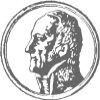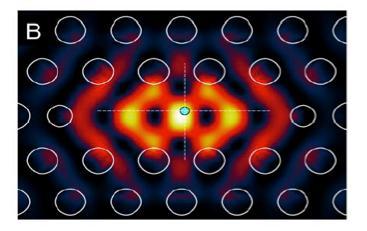Theoretical Physics of Matter: Photonics
Photonics is a wide area of physics, which is concerned with the study of generation, propagation, control and detection of the electromagnetic radiation field, mainly (but not exclusively) in the spectral regions of visible and infrared light. The main topics that are investigated in our Department are:
Photonic Crystals - Photonics crystals are structures characterized by a dielectric function that is periodic on a scale comparable with the wavelength of light of interest. The properties that characterize these systems depends strongly on the geometry, and not only upon their constituent materials. From a theoretical point of view, photonic crystals can be considered as the optical analogous of electronic crystals. Similarly, one can talk about photonic band structures and photonic band gaps. Recently, given the rapid development of tools and techniques for the manipulation, fabrication, and characterization of materials at a length scale below the micrometer, these structures are becoming particular appealing for a broad range of applications.
Light-matter interaction - This topic, which involves concepts from both photonics and solid-state physics, deals with the study of the mutual interaction between the electromagnetic field and matter excitations. Among the investigated topics, we may mention exciton-polaritons and surface plasmon polaritons in several physical systems (bulk semiconductors, quantum wells, quantum dots, and metal nano-structures). A particularly interesting topic is the control of spontaneous emission in an optical cavity; usually, the emitter is a semiconductor quantum-dot or an organic molecule, while the optical cavity can be either metallic or dielectric (e.g. a photonic crystal microcavity, as sketched in the figure). Depending on the strength of the light-matter interaction, one can observe the Purcell effect, i.e. a reduction of the radiative life-time, or strong-coupling, in which one has a reversible exchange of energy between the emitter with the cavity mode with the realization of quantum Rabi oscillations.
Classical and quantum nonlinear optics - This topic deals with the study of the light-matter interaction in the regime of a nonlinear response of the investigated systems, typically described by means of second- and third-order nonlinear susceptibility tensors. The effects under investigation include harmonic generation, Raman scattering, Kerr effect, generation of non-classical states of light by parametric fluorescence, photon blockade, and nonlinear optical phenomena at the single photon level. The main goal of this research activity is the theoretical description of these classical and quantum effects in micro- and nano-structures in which the nonlinear response of the constituent materials can be increased of several orders of magnitudes.
Light trapping: photovoltaic cells and grating couplers - This research activity aims at the study of in- and out-coupling of light in several photonic structures. Among the different applications and topics investigated at the Department, we can mention photovoltaic cells, in which light coupling and light trapping are exploited in the generation of electrical energy. In particular, this research activity is focused on thin-films solar cells made of silicon and other semiconductor with the goal of increasing the efficiency of the device as well as reducing the thickness of the semiconductor layer. The optical study of light trapping is combined with a description of the electronic transport through the solution of the drift-diffusion equations. Finally, in another application, we study the optimization of structures (typically sub-wavelength gratings) to couple light from optical fibers (typically at the telecom wavelength, 1.55 um) into silicon-on-insulator photonic integrated structures. The modelling and design of these systems is an argument of bourgeoning interest with application at the industrial level.
Staff: L.C. Andreani, D.Gerace, M. Liscidini




